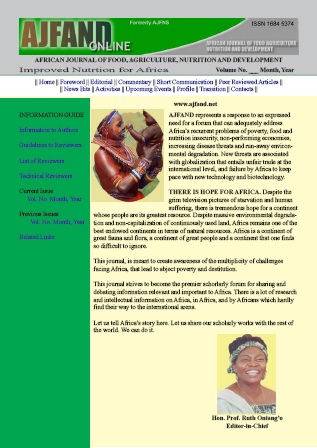
|
African Journal of Food, Agriculture, Nutrition and Development
Rural Outreach Program
ISSN: 1684-5358
EISSN: 1684-5358
Vol. 14, No. 2, 2014, pp. 1-15
|
 Bioline Code: nd14013
Bioline Code: nd14013
Full paper language: English
Document type: Research Article
Document available free of charge
|
|
|
African Journal of Food, Agriculture, Nutrition and Development, Vol. 14, No. 2, 2014, pp. 1-15
| en |
FARM HOLDINGS IN NORTHERN NIGERIA AND IMPLICATION FOR FOOD SECURITY: A REMOTE SENSING AND GIS ASSESSMENT
Soneye, A.S.O.
Abstract
Land is a main life support resource to third world countries. In Nigeria, a major limitation to sustainable land use resources planning, development and management is the unreliable assessment of t available stock and the level of utilization. In particular, the commonly adopted traditional techniques for the evaluation are as questionable as the sources and quality of data adopted and the results being generated. This paper is on evaluation of the per capita farm-size holdings by predominantly peasant farmers in a pure agrarian environment of the country, using the interactive remote sensing technique and Geo-Information System, a computer-based approach for acquisition, integration and processing of spatially-referenced data and their geographical attributes. The area evaluated covers, in parts, six Local Government Areas (LGAs) in the North West Geo-political Zone of the country. The typical Sudano-Sahellian region is within the flood plains of River Sokoto, River Rima and their tributaries which drain the adjoining upland areas into the main River Niger. Remotely-sensed SPOT data of the area were interpreted to assess the extent of the agricultural land cover and uses. Collateral data were from administrative sources, literature searches and field activities. They were integrated to determine the total area extent of the farmlands within both the upland areas which are cultivatable only in a short wet season of less than three month per annum; and the prime floodplain areas which are cultivable all year round. The results were in turn related to the farming population in the region to determine the average lands being cultivated per farmer over the two sub-regions. The findings show that 65.9% of the agricultural lands are in upland regions, and the remaining 34.1% within the floodplain. Farm holdings per head are determined at about 0.61 ha (about 7m by 7m) and less than 0.1 ha (about 3m by 3m) in the two areas respectively. The paper discusses the implication for food security and sustainability in the region.
Keywords
Farm Holding; Food Security; Nigeria
|
| |
© Copyright 2014 - African Journal of Food, Agriculture, Nutrition and Development
Alternative site location: http://www.ajfand.net/
|
|
